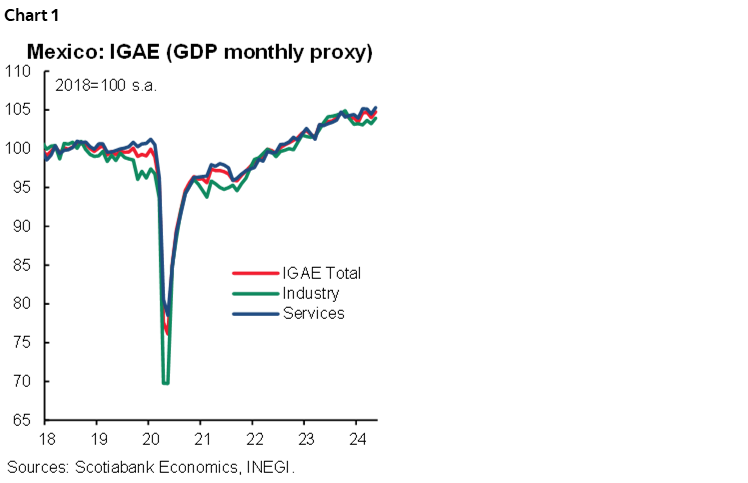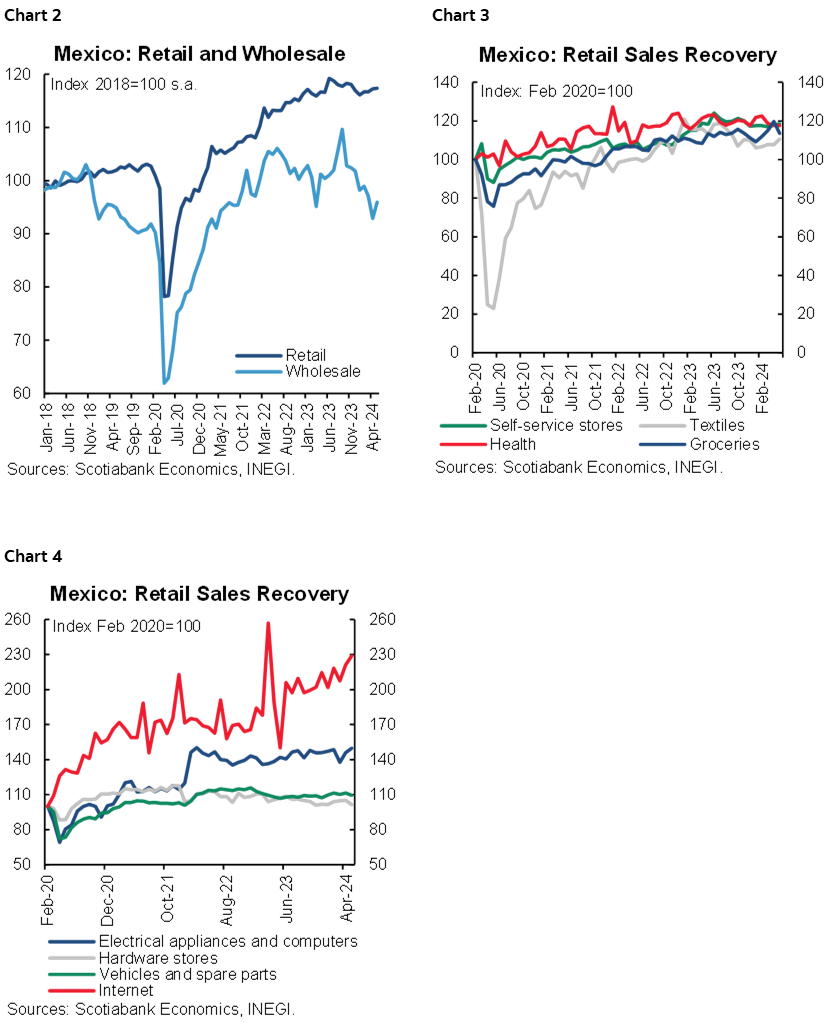- Mexico: Economic activity growth decelerated in May due to industry and services slowdown; Retail sales slowed in May, with declines in four out of nine components
MEXICO: ECONOMIC ACTIVITY GROWTH DECELERATED IN MAY DUE TO INDUSTRY AND SERVICES SLOWDOWN
In May, the GDP monthly proxy, Global Indicator of Economic Activity (IGAE) slowed from to a 1.6% y/y pace of growth from 5.3% previously. By sector, industrial activities slowed sharply from 5.1% to 1.0% y/y owing to a decline in manufacturing of -1.4% from 3.8% and less strong growth in construction, at 10.2% from 16.2% in April, with tailwinds from public infrastructure projects continuing. Services activity also moderated 2.1% y/y from 5.9%, with retail and wholesale trade showing reduced momentum, at 2.4% and 2.7% from 7.2% and 11.5% respectively, while the largest advance came from technical and professional services at 9.9%. Primary activities softened their decline from -4.2% to -1.8% y/y.
On a monthly seasonally adjusted basis, the IGAE rebounded from -0.7% to 0.7%, thanks to a recovery in industrial activity of the same magnitude (0.7% from 0.4% previously)—led by construction—as well as an advance in services (0.8% vs. -0.6% previously) on retail and wholesale trade. Primary activities rebounded to a lesser extent from -0.4% to 0.4%. On a cumulative basis, the IGAE is up 2.3% compared to the same period a year earlier.
During the first half of the year, economic activity has performed at a slower pace than analysts had expected (chart 1). Economists expected that the rise in fiscal spending for this year would have a positive impact on the overall performance of Mexico’s economy particularly in consumption; however, this impulse has not materialized to the desired extent. By sector, manufacturing is facing a period of slow advances, curbed by the restrictive level of interest rates and a slower pace of industrial production in the United States. On the other hand, we believe that construction will continue to advance vigorously, albeit at a slower pace owing to the change of administration in public projects. Finally, services have shown greater resilience, leading the economy’s advance, although recent more moderate increases in trade show signs of moderation, in line with the recent drop in formal employment and lower increases in remittances.

In the coming months, we believe that the pace of economic activity could continue to moderate amid slower consumption and greater uncertainty that could impact investment, leading to further downward revisions in growth expectations, which currently average 2.0% for this year.
RETAIL SALES SLOWED IN MAY, WITH DECLINES IN FOUR OUT OF NINE COMPONENTS
May retail sales slowed 0.3% y/y from 3.2% y/y previously (chart 2). By components, the slower pace of grocery and tobacco trade stood out 0.1% (12.9% previously), textiles fell -2.4% (-7.9% previously), health care -4.6% (-1.3% previously), see chart 3, while internet sales increased 52.7% (18.2% previously), see chart 4. In its monthly comparison, sales increased 0.1% m/m. On an annual basis, wholesale trade fell -4.1% y/y from -2.1%. The deepest fall was in textiles at -15.7% (-23.9% previously), and the largest increase was in intermediation 22.9% (14.7% previously). In monthly terms, wholesale rose 3.3% m/m from -4.3% previously.

In the January to May period, retail sales have increased by 0.8%, compared to the 4.4% in the same period last year, while wholesale has fallen by -3.0% (vs -2.4% in 2023), more related to investment indicators and continuing with the slower pace of the Mexican economy. In contrast, the services sector showed an increase in total income of 5.4% y/y in May, with a lower effect on monetary policy.
These data show a slowdown in sales in most of its components, which can be a good indicator for inflation, mainly in non-food merchandise, although internet sales and intermediation would be the components with the greatest resistance. On the wholesale side, results continue to be weak and without changes in their trend after seventeen months with negative annual variations, suggesting certain weakness in the companies’ growth plans (chart 2 again).
—Brian Pérez & Miguel Saldaña
DISCLAIMER
This report has been prepared by Scotiabank Economics as a resource for the clients of Scotiabank. Opinions, estimates and projections contained herein are our own as of the date hereof and are subject to change without notice. The information and opinions contained herein have been compiled or arrived at from sources believed reliable but no representation or warranty, express or implied, is made as to their accuracy or completeness. Neither Scotiabank nor any of its officers, directors, partners, employees or affiliates accepts any liability whatsoever for any direct or consequential loss arising from any use of this report or its contents.
These reports are provided to you for informational purposes only. This report is not, and is not constructed as, an offer to sell or solicitation of any offer to buy any financial instrument, nor shall this report be construed as an opinion as to whether you should enter into any swap or trading strategy involving a swap or any other transaction. The information contained in this report is not intended to be, and does not constitute, a recommendation of a swap or trading strategy involving a swap within the meaning of U.S. Commodity Futures Trading Commission Regulation 23.434 and Appendix A thereto. This material is not intended to be individually tailored to your needs or characteristics and should not be viewed as a “call to action” or suggestion that you enter into a swap or trading strategy involving a swap or any other transaction. Scotiabank may engage in transactions in a manner inconsistent with the views discussed this report and may have positions, or be in the process of acquiring or disposing of positions, referred to in this report.
Scotiabank, its affiliates and any of their respective officers, directors and employees may from time to time take positions in currencies, act as managers, co-managers or underwriters of a public offering or act as principals or agents, deal in, own or act as market makers or advisors, brokers or commercial and/or investment bankers in relation to securities or related derivatives. As a result of these actions, Scotiabank may receive remuneration. All Scotiabank products and services are subject to the terms of applicable agreements and local regulations. Officers, directors and employees of Scotiabank and its affiliates may serve as directors of corporations.
Any securities discussed in this report may not be suitable for all investors. Scotiabank recommends that investors independently evaluate any issuer and security discussed in this report, and consult with any advisors they deem necessary prior to making any investment.
This report and all information, opinions and conclusions contained in it are protected by copyright. This information may not be reproduced without the prior express written consent of Scotiabank.
™ Trademark of The Bank of Nova Scotia. Used under license, where applicable.
Scotiabank, together with “Global Banking and Markets”, is a marketing name for the global corporate and investment banking and capital markets businesses of The Bank of Nova Scotia and certain of its affiliates in the countries where they operate, including; Scotiabank Europe plc; Scotiabank (Ireland) Designated Activity Company; Scotiabank Inverlat S.A., Institución de Banca Múltiple, Grupo Financiero Scotiabank Inverlat, Scotia Inverlat Casa de Bolsa, S.A. de C.V., Grupo Financiero Scotiabank Inverlat, Scotia Inverlat Derivados S.A. de C.V. – all members of the Scotiabank group and authorized users of the Scotiabank mark. The Bank of Nova Scotia is incorporated in Canada with limited liability and is authorised and regulated by the Office of the Superintendent of Financial Institutions Canada. The Bank of Nova Scotia is authorized by the UK Prudential Regulation Authority and is subject to regulation by the UK Financial Conduct Authority and limited regulation by the UK Prudential Regulation Authority. Details about the extent of The Bank of Nova Scotia's regulation by the UK Prudential Regulation Authority are available from us on request. Scotiabank Europe plc is authorized by the UK Prudential Regulation Authority and regulated by the UK Financial Conduct Authority and the UK Prudential Regulation Authority.
Scotiabank Inverlat, S.A., Scotia Inverlat Casa de Bolsa, S.A. de C.V, Grupo Financiero Scotiabank Inverlat, and Scotia Inverlat Derivados, S.A. de C.V., are each authorized and regulated by the Mexican financial authorities.
Not all products and services are offered in all jurisdictions. Services described are available in jurisdictions where permitted by law.

